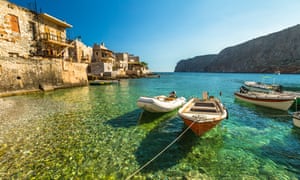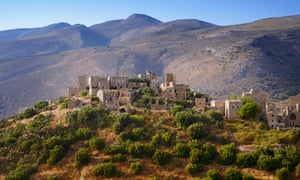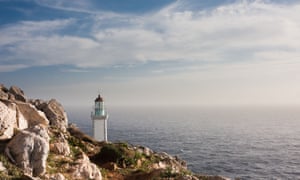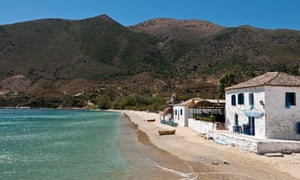
*Main Mani … the village of Gerolimenas is a good option for rooms on the peninsula.
Photograph: Benny Marty/Getty Images
Τhe Mani, the central southern prong of mainland Greece, is divided into two halves. The Outer Mani, with the pretty coastal villages of Kardamyli and Stoupa, is now well known for offering a more authentic holiday experience
than many of the islands.
The Deep Mani, further south, is a different prospect, with its rugged coastline broken by only the occasional cove. Far fewer people visit here, and even fewer stay.
than many of the islands.
The Deep Mani, further south, is a different prospect, with its rugged coastline broken by only the occasional cove. Far fewer people visit here, and even fewer stay.
The Deep Mani starts at the town of Areopoli, above Itylo Bay. Its best-known attraction is on the coast just south of there, and gives you a taste of just how deep this area can get. The Diros caves are extensive and spectacular, but their unique selling point is that you explore them on a punt with your very own underworld ferryman, with the stalactites reflecting in the crystal-clear water.
Most people get no farther than this, but it is well worth carrying on down the coast, where the tourist coaches disappear and even other traffic is rather sparse. Sticking to the coast brings you to sleepy fishing coves like Mezapos, where the fisherman can sometimes be persuaded to take you out to the ruins of the castle on Tigani (frying pan rock). The countryside here is dotted with small, domed Byzantine churches rich in frescoes, but usually kept locked, as well as the distinctive Maniat towerhouses, small clan fortresses.

*The caves of Diros. Photograph: Alamy
The small roads wind and intersect randomly, but if you continue roughly southwards you will soon find yourself descending the dramatic bluff of Cavo Grosso, down to the pretty village of Gerolimenas, set round a pebble beach.
If you want to stay in the Deep Mani, this is one of your best options.
It’s by no means a resort, but there are a few options for all budgets.
The village was once well-known for its export of quails (over 7,000 a month
to France in the 1870s) and the old warehouses have been converted into the Kyramai (doubles from around £85 B&B) – a gorgeous place that pays full attention to local history and tradition, both in its buildings and food.

*Vathia village. Photograph: Alamy
Continuing south, the rocky peninsula starts to narrow, as its east and west coasts rush to their meeting. Vathia, perched high above the sea, shows just how extraordinary this area once was. While many villages have one or two towerhouses, Vathia sprouts a forest of them. It looks like a medieval fantasy, but clan wars were taking place here, often from one side of the windy streets to another, well into the 19th century. The coasts almost do meet between Porto Kagio and Marmari. The former, on the east coast, is named after the quails which were caught here in outstretched nets, before being shipped out of Gerolimenas. Nowadays there is a shingle beach and a couple of fish tavernas, mostly used by the odd yacht that pulls into the bay. To the west, Marmari has a couple of sandy coves, rare for this rocky coast, and above them sits the aptly named Marmari Paradise (doubles €60 B&B) offering good value stone-built rooms and a taverna.

*The lighthouse at Cape Tenaro.
Photograph: Alamy
Photograph: Alamy
If the Diros caves felt like the underworld, then the real thing lurks further to the south. Cape Tenaro (also known as Cape Matapan) separates the Aegean from the Ionian Sea, and in antiquity supposedly hid an entrance to Hades, through which Hercules dragged the three-headed dog Cerberus as one of his 12 tasks. Its exact location is disputed now, but Tenaro still has an end of the world feel. A half-hour walk takes you to the lighthouse at the cape itself.
This is the southernmost tip of mainland eastern Europe; directly south lie the sands of Libya.
Those who thought the west coast of the Deep Mani was remote should now head up the east coast. Here the mountains drop dramatically straight down into the sea and the scattered villages, with their inevitable towerhouses, get few visitors. The first swimming option is the white pebbles and clear waters
of Abela beach. You will generally have this to yourself, but be warned there
are no facilities. Further north the pebble beaches of Kokkala are more accessible, if less attractive, and the village has a taverna and rooms to rent. The tower houses of Nyfi hide a small, but perfectly-formed, little bay, overlooked by another taverna.
of Abela beach. You will generally have this to yourself, but be warned there
are no facilities. Further north the pebble beaches of Kokkala are more accessible, if less attractive, and the village has a taverna and rooms to rent. The tower houses of Nyfi hide a small, but perfectly-formed, little bay, overlooked by another taverna.

*The beach at Skoutari on the eastern coast of the Deep Mani.
Photograph: Alamy
Photograph: Alamy
If you’re seeking sand on this side of the Mani, head for Skoutari. This “local secret” has two shingle and sand beaches backed by a classic little domed Greek church and a whitewashed taverna with tables right on the sand. There are basic rooms here, but more comfortable accommodation can be had in the nearby Skoutari Beach Hotel (doubles from €55). From here you can loop back easily to the “civilisation” of Stoupa and Kardamyli, or continue to the bustling and pretty port of Gythio.
*Photograph: Alamy
* the guardian

Δεν υπάρχουν σχόλια:
Δημοσίευση σχολίου